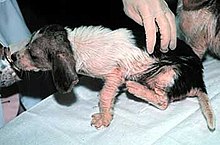Mange
| Mange | |
|---|---|
 | |
| Dog with hair loss caused by Demodex mites | |
| Specialty | Veterinary medicine, dermatology |
Mange (.
Parasitic mites that cause mange in mammals embed themselves in either skin or hair follicles in the animal, depending upon their genus. Sarcoptes spp. burrow into skin, while Demodex spp. live in follicles.
In humans, these two types of mite infections, which would be known as "mange" in furry mammals, are instead known respectively as scabies and demodicosis.
Classification
Demodectic mange

Also called demodicosis or red mange, demodectic mange is caused by a sensitivity to and overpopulation of Demodex spp. The two types of demodectic mange are localized and generalized. Localized consists of four spots or less. Demodex is not zoonotic and is not transferable across species. Each host species has its own species of Demodex. For example, dogs are hosts to Demodex canis and cats are hosts to Demodex cati. A type of demodectic infection in humans is known, but is less commonly symptomatic. See Demodex folliculorum.
Sarcoptic mange



Sarcoptic mange, also known as canine scabies, is a highly contagious infestation of Sarcoptes scabiei var. canis, a burrowing mite. The canine sarcoptic mite can also infest cats, pigs, horses, sheep, and various other species. The human analog of burrowing mite infection, due to a closely related species, is called scabies (the "seven-year itch").
Burrowing mites are in the family Sarcoptidae. They dig into and through the skin, causing intense itching from an allergic reaction to the mite's feces, and crusting that can quickly become infected. Hair loss and crusting frequently appear first on elbows and ears. Skin damage can occur from the dog's intense scratching and biting. Secondary skin infection is also common. Dogs with chronic sarcoptic mange are often in poor condition, and in both animals and humans, immune suppression from starvation or any other disease causes this type of mange to develop into a highly crusted form in which the burden of mites is far higher than in healthy specimens.
Diagnosis
Treatment
Affected dogs are sometimes isolated from other dogs and their bedding, and places they have occupied must be thoroughly cleaned. Other dogs in contact with a diagnosed case should be evaluated and treated. A number of parasitical treatments are useful in treating canine scabies. Sulfurated lime (a mixture of calcium polysulfides) rinses applied weekly or biweekly are effective (the concentrated form for use on plants as a fungicide must be diluted 1:16 or 1:32 for use on animal skin).
Affected cats can be treated with fipronil and milbemycin oxime.[7]
Topical 0.01% ivermectin in oil (
Afoxolaner (oral treatment with a chewable tablet containing afoxolaner 2.27% w/w) has been shown to be efficient against both sarcoptic[8][9] and demodectic[10] mange in dogs.
Free-ranging wombats are commonly treated topically with moxidectin by wildlife carers in Australia,[11] because it poses a low risk.[12]
Sarcoptic mange is transmissible to humans who come into prolonged contact with infested animals,[13] and is distinguished from human scabies by its distribution on skin surfaces covered by clothing. For treatment of sarcoptic infection in humans, see scabies. For demodetic infection in humans, which is not as severe as it is in animals with thicker coats (such as dogs), see Demodex folliculorum.[citation needed]
See also
- Cheyletiella – This genus of mites causes dermatitis and itching in many groups of mammals, including pets and humans, but rarely causes hair loss, so is not usually considered clinically to cause "mange".
- Demodicosis
References
- ^ "Mange – Definition and More from the Free Merriam-Webster Dictionary". Merriam-webster.com. 2010-08-13. Archived from the original on 2011-05-13. Retrieved 2010-11-14.
- ^ "Adult female P-65 is the first mountain lion in study to die of complications from mange". Santa Monica Mountains National Recreation Area. National Park Service. 26 September 2022. Retrieved 18 December 2022.
- .
- .
- ^ "Wild bear mange" (PDF).
- ^ "Sarcoptic Mites and Mange: Also Known As Scabies in Dogs and Cats". Thepetcenter.com. Archived from the original on 1999-10-08. Retrieved 2010-11-14.
- ^ Eldredge, Debra M. (2008). Cat Owner's Home Veterinary Handbook. Howell Book House. p. 145.
- PMID 30516132.

- .
- .
- ^ Borgman W (June 30, 2006). Dog mange called scabies can transfer to humans. Orlando Sentinel archive Archived 2015-02-16 at the Wayback Machine. Retrieved February 16, 2015.
Further reading
- Bornstein, Set; Mörner, Torsten; Samuel, William M. (2001). "Sarcoptes scabiei and Sarcoptic Mange". In Samuel, William M.; Pybus, Margo J.; Kocan, A. Alan (eds.). Parasitic Diseases of Wild Mammals. Wiley. pp. 107–19. ISBN 978-0-8138-2978-4.
External links
 The dictionary definition of mange at Wiktionary
The dictionary definition of mange at Wiktionary
